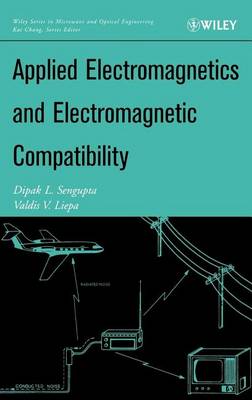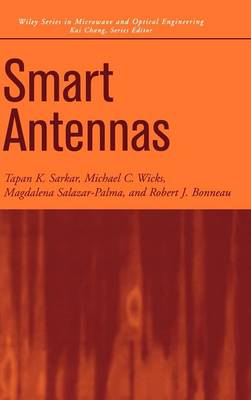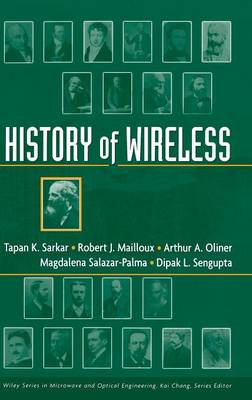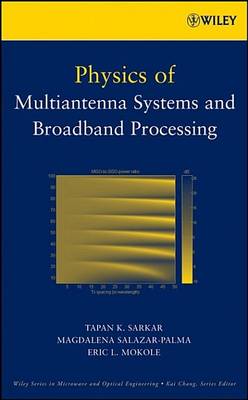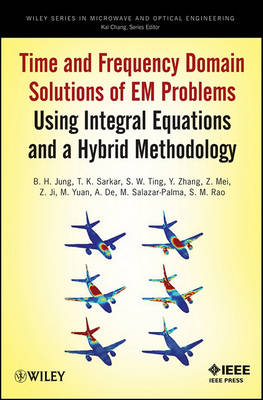Wiley Series in Microwave and Optical Engineering
6 primary works
Book 136
Applied Electromagnetics and Electromagnetic Compatibility
by Dipak L. Sengupta and Valdis V Liepa
Published 1 January 2005
"Applied Electromagnetics and Electromagnetic Compatibility" deals with Radio Frequency Interference (RFI), which is the reception of undesired radio signals originating from digital electronics and electronic equipment. With today's rapid development of radio communication, these undesired signals as well as signals due to natural phenomena such as lightning, sparking, and others are becoming increasingly important in the general area of Electro Magnetic Compatibility (EMC). EMC can be defined as the capability of some electronic equipment or system to be operated at desired levels of performance in a given electromagnetic environment without generating EM emissions unacceptable to other systems operating in the vicinity.
Book 143
Smart Antennas
by T. K. Sarkar, Michael C. Wicks, M. Salazar-Palma, and Robert J. Bonneau
Published 20 May 2003
A valuable addition to the Wiley Series in Microwave and Optical Engineering Today's modern wireless mobile communications depend on adaptive "smart" antennas to provide maximum range and clarity. With the recent explosive growth of wireless applications, smart antenna technology has achieved widespread commercial and military applications. The only book available on the topic of adaptive antennas using digital technology, this text reflects the latest developments in smart antenna technology and offers timely information on fundamentals, as well as new adaptive techniques developed by the authors. Coupling electromagnetic aspects of antenna design with signal processing techniques designed to promote accurate and efficient information exchange, the text presents various mechanisms for characterizing signal-path loss associated with signal propagation, particularly for mobile wireless communications systems based on such techniques as joint space-frequency adaptive processing.
In clear, accessible language, the authors: explain the difference between adaptive antennas and adaptive signal processing Illustrate the procedures for adaptive processing using directive elements in a conformal array clarify multistage analysis procedure which combines electromagnetic analysis with signal processing present a survey of the various models for characterizing radio wave propagation in urban and rural environments describe a method wherein it is possible to identify and eliminate multipath without spatial diversity optimize the location of base stations in a complex environment The text is an excellent resource for researchers and engineers working in electromagnetics and signal processing who deal with performance improvement of adaptive techniques, as well as those who are concerned with the characterization of propagation channels and applications of airborne phased arrays.
In clear, accessible language, the authors: explain the difference between adaptive antennas and adaptive signal processing Illustrate the procedures for adaptive processing using directive elements in a conformal array clarify multistage analysis procedure which combines electromagnetic analysis with signal processing present a survey of the various models for characterizing radio wave propagation in urban and rural environments describe a method wherein it is possible to identify and eliminate multipath without spatial diversity optimize the location of base stations in a complex environment The text is an excellent resource for researchers and engineers working in electromagnetics and signal processing who deal with performance improvement of adaptive techniques, as well as those who are concerned with the characterization of propagation channels and applications of airborne phased arrays.
Book 177
History of Wireless
by T. K. Sarkar, Robert Mailloux, Arthur A. Oliner, M. Salazar-Palma, and Dipak L. Sengupta
Published 1 January 2006
This work presents important new insights into how various components and systems evolved. Premised on the idea that one cannot know a science without knowing its history, "History of Wireless" offers a lively new treatment that introduces previously unacknowledged pioneers and developments, setting a new standard for understanding the evolution of this important technology. Starting with the background - magnetism, electricity, light, and Maxwell's Electromagnetic Theory - this book offers new insights into the initial theory and experimental exploration of wireless. In addition to the well-known contributions of Maxwell, Hertz, and Marconi, it examines work done by Heaviside, Tesla, and passionate amateurs such as the Kentucky melon farmer Nathan Stubblefield and the unsung hero Antonio Meucci. Looking at the story from mathematical, physics, technical, and other perspectives, the clearly written text describes the development of wireless within a vivid scientific milieu. "History of Wireless" also goes into other key areas, including: The work of J. C. Bose and J. A.
Fleming; German, Japanese, and Soviet contributions to physics and applications of electromagnetic oscillations and waves; Wireless telegraphic and telephonic development and attempts to achieve transatlantic wireless communications; Wireless telegraphy in South Africa in the early twentieth century; Antenna development in Japan: past and present; Soviet quasi-optics at near-mm and sub-mm wavelengths; The evolution of electromagnetic waveguides; and, The history of phased array antennas. Augmenting the typical, Marconi-centered approach, "History of Wireless" fills in the conventionally accepted story with attention to more specific, less-known discoveries and individuals, and challenges traditional assumptions about the origins and growth of wireless. This allows for a more comprehensive understanding of how various components and systems evolved. Written in a clear tone with a broad scientific audience in mind, this exciting and thorough treatment is sure to become a classic in the field.
Fleming; German, Japanese, and Soviet contributions to physics and applications of electromagnetic oscillations and waves; Wireless telegraphic and telephonic development and attempts to achieve transatlantic wireless communications; Wireless telegraphy in South Africa in the early twentieth century; Antenna development in Japan: past and present; Soviet quasi-optics at near-mm and sub-mm wavelengths; The evolution of electromagnetic waveguides; and, The history of phased array antennas. Augmenting the typical, Marconi-centered approach, "History of Wireless" fills in the conventionally accepted story with attention to more specific, less-known discoveries and individuals, and challenges traditional assumptions about the origins and growth of wireless. This allows for a more comprehensive understanding of how various components and systems evolved. Written in a clear tone with a broad scientific audience in mind, this exciting and thorough treatment is sure to become a classic in the field.
Book 198
Physics of Multiantenna Systems and Broadband Processing
by T. K. Sarkar, M. Salazar-Palma, and Eric L. Mokole
Published 5 November 2007
An analysis of the physics of multiantenna systems Multiple-Input Multiple-Output (MIMO) technology is one of the current hot topics in emerging wireless technologies. This book fills the important need for an authoritative reference on the merits of MIMO systems based on physics and provides a sound theoretical basis for its practical implementation. The book also addresses the important issues related to broadband adaptive processing.
Written by three internationally known researchers, Physics of Multiantenna Systems and Broadband Processing: Provides a thorough discussion of the physical and mathematical principles involved in MIMO and adaptive systems Examines the electromagnetic framework of wireless communications systems Uses Maxwell's theory to provide a system-based framework for the abstract concept of channel capacity Performs various numerical simulations to observe how a typical system will behave in practice Provides a mathematical formulation for broadband adaptive processing and direction-of-arrival estimation using real antenna arrays Integrates signal processing and electromagnetics to address the performance of realistic multiantenna systems With Physics of Multiantenna Systems and Broadband Processing, communication systems engineers, graduate students, researchers, and developers will gain a thorough, scientific understanding of this important new technology.
Written by three internationally known researchers, Physics of Multiantenna Systems and Broadband Processing: Provides a thorough discussion of the physical and mathematical principles involved in MIMO and adaptive systems Examines the electromagnetic framework of wireless communications systems Uses Maxwell's theory to provide a system-based framework for the abstract concept of channel capacity Performs various numerical simulations to observe how a typical system will behave in practice Provides a mathematical formulation for broadband adaptive processing and direction-of-arrival estimation using real antenna arrays Integrates signal processing and electromagnetics to address the performance of realistic multiantenna systems With Physics of Multiantenna Systems and Broadband Processing, communication systems engineers, graduate students, researchers, and developers will gain a thorough, scientific understanding of this important new technology.
Book 214
Parallel Solution of Integral Equation-Based EM Problems in the Frequency Domain
by Y. Zhang and T. K. Sarkar
Published 1 January 2009
A step-by-step guide to parallelizing cem codes The future of computational electromagnetics is changing drastically as the new generation of computer chips evolves from single-core to multi-core. The burden now falls on software programmers to revamp existing codes and add new functionality to enable computational codes to run efficiently on this new generation of multi-core CPUs. In this book, you'll learn everything you need to know to deal with multi-core advances in chip design by employing highly efficient parallel electromagnetic code.
Focusing only on the Method of Moments (MoM), the book covers: In-Core and Out-of-Core LU Factorization for Solving a Matrix Equation A Parallel MoM Code Using RWG Basis Functions and ScaLAPACK-Based In-Core and Out-of-Core Solvers A Parallel MoM Code Using Higher-Order Basis Functions and ScaLAPACK-Based In-Core and Out-of-Core Solvers Turning the Performance of a Parallel Integral Equation Solver Refinement of the Solution Using the Conjugate Gradient Method A Parallel MoM Code Using Higher-Order Basis Functions and Plapack-Based In-Core and Out-of-Core Solvers Applications of the Parallel Frequency Domain Integral Equation Solver Appendices are provided with detailed information on the various computer platforms used for computation; a demo shows you how to compile ScaLAPACK and PLAPACK on the Windows(r) operating system; and a demo parallel source code is available to solve the 2D electromagnetic scattering problems. Parallel Solution of Integral Equation-Based EM Problems in the Frequency Domain is indispensable reading for computational code designers, computational electromagnetics researchers, graduate students, and anyone working with CEM software.
Focusing only on the Method of Moments (MoM), the book covers: In-Core and Out-of-Core LU Factorization for Solving a Matrix Equation A Parallel MoM Code Using RWG Basis Functions and ScaLAPACK-Based In-Core and Out-of-Core Solvers A Parallel MoM Code Using Higher-Order Basis Functions and ScaLAPACK-Based In-Core and Out-of-Core Solvers Turning the Performance of a Parallel Integral Equation Solver Refinement of the Solution Using the Conjugate Gradient Method A Parallel MoM Code Using Higher-Order Basis Functions and Plapack-Based In-Core and Out-of-Core Solvers Applications of the Parallel Frequency Domain Integral Equation Solver Appendices are provided with detailed information on the various computer platforms used for computation; a demo shows you how to compile ScaLAPACK and PLAPACK on the Windows(r) operating system; and a demo parallel source code is available to solve the 2D electromagnetic scattering problems. Parallel Solution of Integral Equation-Based EM Problems in the Frequency Domain is indispensable reading for computational code designers, computational electromagnetics researchers, graduate students, and anyone working with CEM software.
Book 220
Time and Frequency Domain Solutions of EM Problems
by B. H. Jung, T. K. Sarkar, Y. Zhang, Z. Ji, M. Yuan, M. Salazar-Palma, S. M. Rao, S. W. Ting, Z Mei, and A. De
Published 19 November 2010
Numerical solutions of electromagnetic field problems is an area of paramount interest in academia, industry and government. This book provides a compendium of solution techniques dealing with integral equations arising in electromagnetic field problems in time and frequency domains. Written by leading researchers in the field, it documents the authors' unique space/time separation approach using Laguerre polynomials. Numerous examples that illustrate the various methodologies and user-friendly computer codes make this volume highly accessible for engineers, researchers, and scientists.
